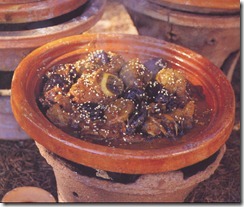Eating In – a Taste of Morocco
I have only visited Morocco once, and that was for a three day conference of an American multi-national corporation. It rained for two and a half days and the streets of Marrakech ran with a thin red mud. The conference leader stayed in his room most of the time, with what one of his aides called ‘a low fever’, sending for milk and crackers (dry biscuits) now and then. So as he was indispensable to the proceedings most of them were cancelled and there was ample time to explore the local cuisine, splashing our way under umbrellas to taxis which took us to various good eating establishments. There we came upon the Tagine.
Nowadays, of course, everyone knows what a Tagine is – a rather tasty melange cooked in a casserole. In fact, it is the name of the actual pot in which the food is cooked. Such pots are earthenware, distinguished by a conical lid. Both savoury and sweet dishes are cooked in them. Cooking is done slowly, over coals or charcoal. This cooking implement is unique to Morocco and some of the recipes are quite unusual too, using fruit, nuts and spices.
To get the genuine flavour of the cooking of Morocco, I regularly turn to an excellent book by Kitty Morse, who shares her time between southern California, where she teaches, demonstrates and writes about Moroccan food, and her home in Azemmour, Morocco. It is called “Cooking at the Kasbah” (Chronicle Books, San Francisco, USD 20.65 on-line) – a 156 medium format paperback, on art paper with very good photographs.
Mrs Morse has collected recipes from many sources. Most of them can be cooked here quite easily, the ingredients being readily available. I doubt if you want to cook your Tagine in an earthenware pot over hot coals, but the recipes work perfectly using a heavy pan with lid. I find Le Creuset cast-iron enamelled casseroles perfect.
I have tested and adapted one of this super book’s recipes and can heartily recommend it. I leave the author’s introduction to the recipe intact.
“The Centre de Formation en Restauration Traditionnelle, a government-sponsored cooking school in Rabat, is dedicated to preserving the art of traditional Moroccan gastronomy. The students, all young women, will go on to staff Morocco’s embassies and consulates around the world. This classic tagine recipe, given to me by the Centre’s former director, Monsieur Tamer, is part of the school’s delectable curriculum” Kitty Morse
Ingredients for 4 – 6 Servings
2 tbsp olive oil
8 – 10 pitted prunes (according to size – or you may mix some prunes with dried apricots or figs)
1 tsp ground turmeric
2 tbsp honey
1 tsp ground ginger
1 tsp ground cinnamon
1 kilo / 2.2 lbs meat from a leg of lamb, trimmed of fat and cut into 5 cm / 2-inch chunks
25 cl /8 fl oz chicken stock
Black pepper
Two medium onions
1 tablespoon sesame seeds
1 cup chicken broth
8 threads Spanish saffron, chopped and put into a cup of boiling water for a few minutes
3 sprigs of coriander or parsley, chopped
Method
- In a small heavy casserole, heat the oil and fry the turmeric, ginger, and lamb until the meat is well coated and lightly browned, for about three minutes.
- Finely dice one of the onions. Add it to the meat along with the chicken stock. the saffron and coriander or parsley.
- Cover and reduce the heat to medium-low. Cook until the meat is tender, which will be one to 1½ hours.
- Heat the oven to 100°C / 200°F
- Take a slotted spoon, transfer the meat to an ovenproof dish and keep warm in the oven until ready to serve.
- Bring the sauce in the casserole back to a simmer, then slice the remaining onion. Add it, along with the prunes, honey, cinnamon, and pepper to the simmering sauce.
- Season. Cook until the mixture thickens a little. Around 6 – 8 minutes.
- Spoon the prune sauce over the meat and sprinkle the dish with the sesame seeds.
- Serve with warm bread.
When I made this dish I served it with couscous, laced with peas, which was a marvellous foil for the lovely fruity sauce. The local lamb was ideal.
Wine Match: Bags of flavour here, so I think a rounded, fruity, full-bodied red is required and I would go for a Chilean Pinot Noir, of which a number are available here at varying prices.
